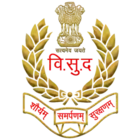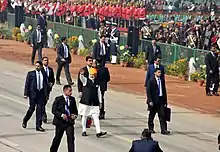Special Protection Group
The Special Protection Group (SPG) is a special operations force whose objective is providing proximate security to the Prime Minister of India and members of their immediate families anywhere in the world. It was formed in 1988 by an Act of the Parliament of India.[4]:para 1[5]
| Special Protection Group | |
|---|---|
 SPG Logo | |
 | |
| Abbreviation | SPG |
| Motto | Bravery, Dedication, Security |
| Agency overview | |
| Formed | 8 April 1985 |
| Employees | 3,000 active personnel[1] |
| Annual budget | ₹592.5 crore (US$83 million)(2020-21 est.)[2] |
| Jurisdictional structure | |
| Federal agency (Operations jurisdiction) | India |
| International agency | India |
| Countries | India and abroad[3] |
| Operations jurisdiction | India |
| Legal jurisdiction | As per operations jurisdiction |
| Governing body | Cabinet Secretariat of India |
| Constituting instrument | |
| General nature | |
| Specialist jurisdiction |
|
| Operational structure | |
| Headquarters | New Delhi |
| Agency executive |
|
| Website | |
| spg | |
It provides security only to the Prime Minister of India and their immediate family members residing with them at the official residence.[6][7]
Earlier, it used to provide security to former prime ministers as well, but they are now given the Z+ security cover.[8]
History
Before 1981, the security of the Prime Minister at the official residence was the responsibility of the Special Security District of the Delhi Police under the charge of Deputy Commissioner of Police (DCP). In October 1981, a Special Task Force (STF) was raised by the Intelligence Bureau (IB) to provide ring-round and escort to the Prime Minister in and out of New Delhi.
After the assassination of Prime Minister Indira Gandhi in October 1984, a review was undertaken by a Committee of Secretaries and it was decided to entrust security of the Prime Minister to a Special Group under unitary and direct control of a designated Officer and the STF to provide immediate security cover both in New Delhi and outside. These decisions were taken as short-term measures.
Then on 18 February 1985, the Ministry of Home Affairs set up the Birbal Nath Committee to go into the issue in its entirety and submit its recommendation. In March 1985, the Birbal Nath Committee submitted its recommendations of raising a Special Protection Unit (SPU). On 30 March 1985, the President of India created 819 posts for the unit under the Cabinet Secretariat. The SPU was then re-christened Special Protection Group and the post of Inspector General of Police was re-designated as Director.
The SPG came into being on 8 April 1985[9] when S. Subramaniam, then Joint Director (VIP Security) in the Intelligence Bureau assumed office. Creation of the SPG required an elaborate exercise in order to clearly delineate responsibility of various agencies concerned with the security of the Prime Minister. The provisions contained in the Blue Book, which lays down security guidelines for the protection of the Prime Minister, had to be harmoniously blended with this new concept of proximate security.
IB and the State/UT Police concerned were responsible for coordination, collection and dissemination of intelligence affecting VIP security. State/UT Police and the SPG were responsible for providing physical security arrangements for the Prime Minister, while the IB was to provide the required intelligence inputs to these operational agencies. The SPG functioned as a security group purely on the strength of an executive order for three years without a legislation, from April 1985 to June 1988.
The SPG was constituted and trained specially to provide protection to Prime Minister Rajiv Gandhi, in view of the threats to him from several sources. But, the organization created for the proximate security of Prime Minister Gandhi, did not contemplate provision of protection to him when he ceased to be Prime Minister, and faced magnified threats. SPG cover for Rajiv Gandhi was withdrawn once he ceased to be Prime Minister. After the assassination of Rajiv Gandhi in May 1991, the SPG Act was amended in 1991 to provide security to former Prime Ministers and their immediate families for a period of 10 years from the date on which the former Prime Minister ceased to hold office.
On 27 November 2019, SPG amendment bill 2019 was passed by Lower House of Indian Parliament, which reduced SPG cover only to the PM and his immediate kin, and ex-PM and his family for 5 years. The act seeks to bring down the cost of maintaining the SPG security to the exchequer.[10]
Command and control
The "general superintendence, direction and control" of the SPG is exercised by the Central Government.[4] The head of the force, called a Director, designated as Secretary in the Cabinet Secretariat is responsible for "the command and supervision" of the force.[4] The director of the SPG since its inception has been an officer from the Indian Police Service.[11] Personnel of the Special Protection Group are drawn from Central Armed Police Forces and Railway Protection Force, but the officers are from the IPS or CRPF.
Organization
The Director of the "SPG", an officer of Director General, designated as Secretary (Security) in the Cabinet Secretariat, and sometimes Inspector General rank, designated as Joint Secretary (Security) in the Cabinet Secretariat, is assisted by number of Deputy Directors, Assistant Directors, Joint Assistant Directors.[4][11] The SPG is divided broadly into the following four categories:
- Operations: Looks after the actual protection duties. In the Operations Branch, there are components like the Communications Wing, Technical Wing and Transport Wing.
- Training: Deals with the training of personnel on a continuous basis. The SPG imparts training in physical efficiency, marksmanship, anti-sabotage checks, communication and other operative aspects connected with close protection drills and having a bearing on VVIP security with a view to maintaining a high level of physical fitness and to fine-tune the operational skills of SPG Special Agents and Uniformed Officers. The training programme is constantly reviewed and updated to effectively thwart threats from newer areas and in keeping with existing threat perception.
- Intelligence and tours: threat assessment, internal intelligence pertaining to personnel, verification of character and antecedents, tours and other allied jobs.
- Administration: Deals with personnel, finance, procurement and other related matters.
Uniform and dress
.jpg.webp)
Generally, SPG special agents assigned to the prime ministerial security detail wear black Western-style formal business suits with dark sunglasses, a 2-way encrypted communication earpiece, and concealed handguns. Rarely, on traditional occasions, they wear safari suits to blend into the environment.
SPG uniformed officers are dressed like special operations commandos but with much more noticeable armament. Their personal equipment include ultra-modern assault rifles, dark-visor goggles/sunglasses with inbuilt communication earpieces, bulletproof vests, gloves and elbow/knee pads.
Current SPG cover
| SI No. | Name | Designation |
|---|---|---|
| 1 | Narendra Modi | Prime Minister of India |
Narendra Modi, being the Prime Minister of India, is under the SPG protection. Sonia Gandhi and her children, Rahul Gandhi and Priyanka Gandhi, were given the SPG protection because, two of their family members, Indira Gandhi and Rajiv Gandhi, both former Prime Ministers of India, were assassinated. On 8 November 2019, Government of India decided to withdraw SPG Cover from Nehru–Gandhi family and accorded them with Z+ Security after the threat assessment.
Arms and equipment

Weapons
- FN Herstal F2000[12]- Special Intervention Unit (SIU)
- FN SCAR- Special Intervention Unit (SIU)
- FN Herstal Five-seveN,[12][13]- Special Agents(SIU) and Uniformed Officers
- Glock 17 or Glock 19 - Uniformed Officers
- FN Herstal P90[12][13][14] -Uniformed Officers only
- IOF Modern Sub Machine Carbine - Selected to be used by the SPG after trials in 2019
Vehicles
The Prime Minister's motorcade comprises a fleet of vehicles, the core of which consists of at least three armored BMW 7 Series sedans, two armored Range Rovers, at least 8-10 BMW X5s, six Toyota Fortuners/Land Cruisers and at least two Mercedes-Benz Sprinter ambulances. A Tata Safari ECM car also accompanies the convoy, besides many more escort vehicles.
These customized armoured variants of the standard 2015 BMW 760Li long-wheelbase sedan are used to transport the Prime Minister. They are certified with VR7 in the BRV 2009 ballistics protection ratings, and can defend occupants from anything between landmine blasts and machine-gun fire. Security upgrades include undercarriage armour, 76 mm (3 in) thick multi-layer laminated glass and armour plating on the doors, roof, body pillars, front footwell and rear bulkhead. They have run-flat tyres which can run deflated for kilometers. The cars are fitted with advanced heat sensors to ward off missiles and bombs. While the fuel tanks are Kevlar-sealed so as not to explode during an attack, their cabins also turn into gas-proof chambers and ensure fresh oxygen supply to secure the occupants in cases of chemical and biological attacks. Other rumoured features include an intercom system between the passengers and the driver, an alarm, a fire extinguisher with temperature sensor, irritant gas sensors (to warn of dangerous gasses in the passenger area), and a compartment for two machine guns in the center console. Due to the added weight of the security upgrades, suspension components such as the shock absorbers and strut tops are upgraded as compared to a normal 760Li.
For official movement, the Indian flag is fender-mounted on the driver's side of the vehicles, and if taken abroad, the flag of the foreign country is fender-mounted on the passenger's side.
These armoured variants of the standard wheelbase 2016 Range Rover Autobiography SUV are used as backup to the BMW 760Li sedans for transportation of the Prime Minister. If not being used by the Prime Minister himself/herself, they are used to transport members of the Prime Minister's immediate family accompanying him/her as part of the motorcade. These SUVs are armoured by Land Rover's Special Vehicle Operations facility in Coventry, England, and are certified with VR8 in the BRV 2009 ballistics protection ratings. They can withstand some of the most damaging and targeted of threats, including penetration by 7.62mm high velocity armour piercing incendiary bullets, they can protect occupants against up to 15 kg lateral Trinitrotoluene (TNT) blasts and defend against DM51 grenade explosions from both beneath the floor and above the sunroof. Run-flat tyres allow the vehicle to be driven even if the tyres are deflated. The chassis is reinforced with super-high-strength steel, and the standard glass has been replaced by multi-laminated armoured privacy glass of optical quality. The suspension is upgraded as compared to the standard Range Rover, while an anti-tamper exhaust, self-sealing fuel tank, auxiliary back-up battery and split-charging battery system provide added protection and security.
Just like the BMW 760Li's, the Indian flag is fender-mounted on the driver's side of the vehicles. However, these SUVs, even if taken abroad, do not bear the flag of the foreign country, and will instead have the Indian flag itself or a flag with the State Emblem of India fender-mounted on the passenger's side.
These SUVs carry the SPG Special Agents and Uniformed Officers assigned to the Prime Ministerial Security Detail. At least 8 BMW X5s, 6 Fortuners and 2 Land Cruisers accompany the motorcade at all times. The X5s in particular are armoured to VR6 in the BRV 2009 ratings, but the protection levels on the Toyota SUVs are undisclosed.
These are armoured tactical medical support vehicles to the Prime Minister, at least two of which are always spotted to the rear of the motorcade. They carry at least a litre of the Prime Minister's blood type, for emergency transfusions.
- Tata Safari Storme Electronic Countermeasures Vehicle
This vehicle is used to counter guided attacks, such as IEDs, Rocket Propelled Grenades, and Anti-Tank Guided Missiles. The antennas mounted on the roof are used in barrage jamming applications and for scouting purposes, the primary method used to counter IED threats. The antenna configuration can be changed according to threat level, for instance, taller antennas are used to increase the jamming protection distance, or change jamming frequency ranges. There are two dome-shaped EW Sensors. The EW sensors are millimetre-wave radars used to detect the launch of an RPG (Rocket Propelled Grenades) or laser range finder illumination and launch of an Anti-Tank Guided Missile (ATGM).
Air transport
- Air India One: Air India One, also referred to as AI1, is the call sign of any aircraft carrying the Prime Minister of India, President of India or the Vice President of India. These flights are operated as VIP flights by the Indian Air Force (IAF). Apart from the interior-modified Boeing 747-400 and Boeing 777-300ER fleet owned by Air India, the IAF currently owns four 14-seater Embraer-135 and three customized 46-seater Boeing Business Jet BBJ) 737s that have a VIP cabin and are used for domestic VVIP movement. The 747s are used by either the Prime Minister, President or Vice President when on official long-haul overseas visits. The Government of India has chosen the ultra long-haul Boeing BBJ 777-300ER to replace the aging 747s for VVIP use on long-haul trips. PM Narendra Modi once used an Indian Air Force Lockheed C-130J during his visit to Sri Lanka.
.jpg.webp)
- Mi-17 helicopters: The Defence Ministry has approved the "conversion" of six new Mi-17 V5s to replace the old Mi-8 helicopters with IAF's elite Communication Squadron to ferry the President and Prime Minister. Mi-17 V5s have advanced avionics, on-board navigation systems and night-vision devices. The SPG wanted the helicopters to have "high tail booms" to allow cars to come right next to the rear exit staircase without "exposing" passengers to a threat from anyone in the vicinity, additional transit range, better crashworthiness and armour protection.
Contact with the media
Members of the SPG are barred by the SPG Act, 1988, from contact with the media and from publishing or collaborating in the publication of "any book, letter or other document".[4]
See also
- Special Forces of India
- National Security Guard
References
- (IISS), International Institute for Strategic Studies (2017). The Military Balance 2017. Routledge. ISBN 9781857439007.
- "MINISTRY OF HOME AFFAIRS" (PDF). indiabudget.gov.in. Retrieved 12 September 2018.
- Section 6, Special Protection Group Act, 1988
- The Gazette of India (7 June 1988). "THE SPECIAL PROTECTION GROUP ACT 1988 [AS AMENDED IN 1991, 1994 & 1999]". No. 30. New Delhi: The Government of India. Archived from the original on 20 October 2014. Retrieved 22 May 2014.
- "Mayawati not entitled to SPG cover under law - The Times of India". The Times Of India.
- "Govt. ends SPG protection for Sonia, Rahul & Priyanka". The Hindu. 9 November 2019. Retrieved 9 November 2019.
- "SPG amendment bill passed in Lok Sabha". The Economic Times. 27 November 2019. Retrieved 27 November 2019.
- "What is the Special Protection Group and why Manmohan Singh's security cover was removed". The Print. 26 August 2019. Retrieved 9 November 2019.
- "About Us :: SPG, Govt. of India". www.spg.nic.in. Retrieved 27 May 2019.
- "English Releases". pibarchive.nic.in. Retrieved 28 November 2019.
- "Prasad's appointment as SPG chief stuns many". Times of India. 3 November 2011. Retrieved 23 May 2014.
- Unnithan, Sandeep (22 August 2008). "If looks could kill". India Today. Retrieved 4 April 2009.
- Unnithan, Sandeep (1 September 2005). "SPG Gets More Teeth". India Today (ISSN 0254-8399).
- Swami, Praveen (8 April 2009). "Mumbai Police's Modernisation Programme Built Around Outdated, Inappropriate Weapons". Chennai, India: The Hindu: Online Edition of India's National Newspaper. Retrieved 29 August 2009.
External links
| Wikimedia Commons has media related to Special Protection Group. |
- SPG. "Special Protection Group".: Official Website of SPG
- Gazette notification of Special Protection Group Act
- new wing of SPG.
